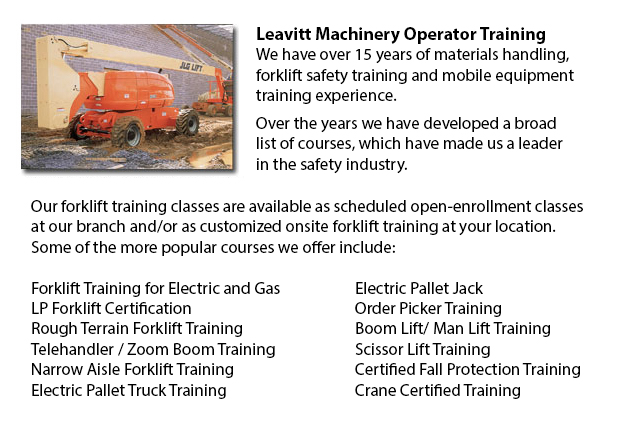
Aerial Lift Safety Training Vaughan - There are roughly 26 to 30 construction deaths in North America due to the use of aerial lifts. Most of the individuals killed are craftsmen like for example electrical workers, laborers, painters, carpenters or ironworkers. The majority of the fatalities are caused by tip-overs, electrocutions and falls. The greatest hazard is from boom-supported lifts, like for instance bucket trucks and cherry pickers. The majority of the deaths are related to this particular type of lift, with the rest involving scissor lifts. Other dangers comprise being thrown out of a bucket, being struck by falling objects, and being caught between the lift bucket or guardrail and a thing, such as a joist or steel beam.
The safe operation of an aerial lift requires a check on the following items before using the device: emergency and operating controls, personal fall protection gear, safety devices, and wheels and tires. Look for possible leaks in the air, fuel-system, hydraulic fluid. Check the device for loose or missing parts.
The place where the device will be used must be thoroughly checked for possible hazards, like bumps, holes, debris and drop-offs. Overhead power lines must be avoided or closely monitored. It is suggested that aerial lift devices be utilized on surfaces which are level and stable. Never work on steep slopes which exceed slope restrictions specified by the manufacturer. Even on a slope that is level, wheel chocks, outriggers and brakes must be set.
Employers are required to provide aerial lift operators and maintenance mechanics with the right instruction manuals. Mechanics and operators need to be trained by a certified person experienced with the relevant kind of aerial lift.
Aerial Lift Safety Guidelines:
o Close lift platform chains or doors prior to operating.
o Climbing on and leaning over guardrails is prohibited. Stand on the platform or floor of the bucket.
o Stay within manufacturer's load-capacity limitations.
o When working near traffic, utilize proper work-zone warnings, such as signs and cones.
If correct procedures are followed, electrocutions are avoidable. Stay at least ten feet away from whatever power lines and qualified electricians must insulate and/or de-energize power lines. Workers must make use of personal protective tools and equipment, such as a bucket that is insulated. However, a bucket that is insulated does not protect from electrocution if, for instance, the worker touches another wire providing a path to the ground.
When within the bucket, workers need to prevent possible falls by securing themselves to the guardrails by utilizing a full-body harness or a positioning device. If there is an anchorage within the bucket, a positioning belt along with a short lanyard is adequate.
By following the manufacturer's directions, tip-overs can be prevented. Never drive the lift platform when it is elevated, unless the manufacturer specifies otherwise. Adhere to the horizontal and vertical reach limits of the device, and never exceed the load-capacity which is specified.
-
Forklift License Vaughan
Forklift License Vaughan - Getting a forklift certification or forklift license in North America would require the trainee to do hands-on training in addition to classroom instruction. The provincial, federal and state regulatory bodies are responsib... More -
Forklift Ticket Vaughan
Forklift Ticket Vaughan - Forklifts and the pallet jack is meant for just about the same reason. They work to raise and move supplies and goods from one place to another. This however is where the comparison stops though. With the pallet jack, the be... More -
Aerial Lift Certification Vaughan
Aerial Lift Certification Vaughan - Aerial Lift Certification is for individuals who need an in-depth understanding of aerial lift safety. Operators and inspectors, supervisors, maintenance workers and construction craftsmen should perform a certific... More -
Manlift Certification Vaughan
Manlift Certification Vaughan - The Manlifts and Elevated Platforms course provides training on the rules, regulations and proper application of safe operating measures and work practices included in everyday activities for those who work making use... More -
Heavy Equipment Training Vaughan
Heavy Equipment Training Vaughan - The two most common kinds of heavy equipment training are categorized into the categories of machines; equipment that is fashioned with rubber tires or those with tracks. The tracked vehicle are heavy duty machines... More -
Boom Lift Ticket Vaughan
Boom Lift Ticket Vaughan - Boom lifts are equipment that has a platform that may be lowered or raised to different heights, thus making this piece of equipment an important necessity in a wide variety of professions. Offered in many different particu... More -
Telehandler License Vaughan
Telehandler License Vaughan - The telescopic handler or telehandler is a frequently used equipment in industrial and agricultural applications. This particular machine is the same in appearance to a forklift and also functions in a similar way, altho... More -
Scissor Lift Training Vaughan
Scissor Lift Training Vaughan - Scissor lifts have to be operated competently to be able to protect the safety of the machinery and the safety of others within the workplace. Operators who are skilled are trained to drive the particular kind of sciss... More

Forklift Training Vaughan
TOLL FREE: 1-888-254-6157
Vaughan, Ontario
forklifttrainingvaughan.com
Email Us
About Us


